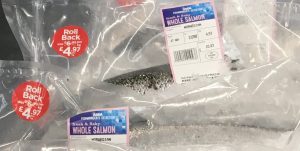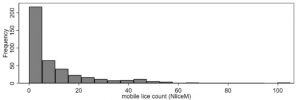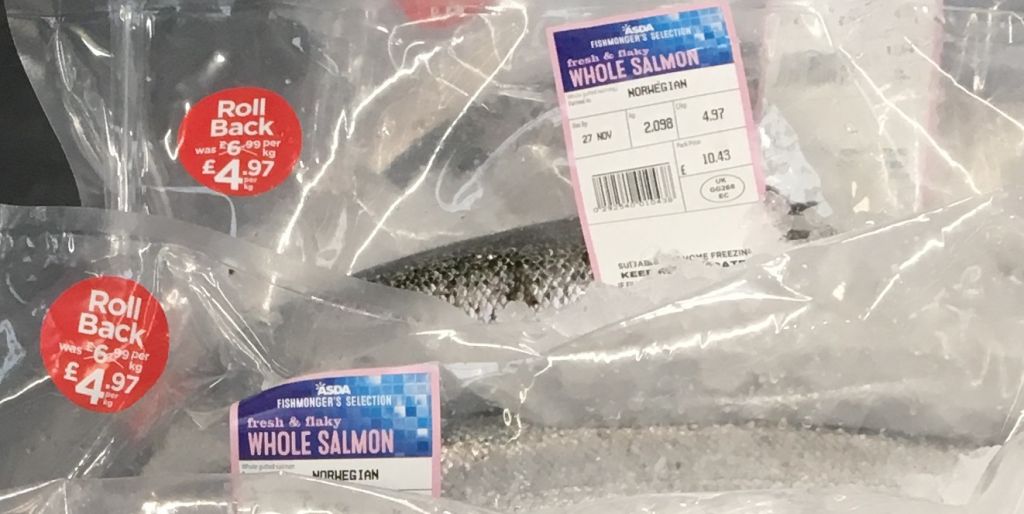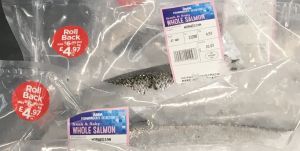Don’t mince your words: The latest issue of ‘The Voice of Arran’ includes a commentary from ‘local marine scientist, activist and writer’ Sally Campbell in which she said that she was somewhat surprised to see an Asda Christmas advert in the Daily Mail promoting Scottish farmed salmon for £4.97/kg. She said that at this price, salmon is cheaper than mince at £5/kg. She asks how on earth can a profit margin be made at that price bearing in mind the fish has been growing for up to three years, fed, disease controlled, prepared for the supermarket, distributed over the country and marketed in the national media?
Dr Campbell is happy to provide an explanation. She says that firstly the salmon industry in Scotland externalises a lot of the production costs and the marine environment picks up the price. She says that no payment is made for waste disposal, whether of feed, medication or faeces. She continues that as the price of salmon drops, then there is pressure to grow more fish in each pen and increased stocking means increased diseases, thus increasing the amount of chemicals and medications used.
She adds that the pressure to reduce cost has meant a move to automated feeding so reducing full time jobs. Feed was boosted by the availability of Antarctic krill leading to an 80% reduction in krill stocks.
For these reasons, Asda are able to sell their salmon for £4.97/kg. She says it is a race to the bottom.
Except, like most anti-salmon farming critics, Dr Campbell has made so many assumptions based on what she thinks she knows in order to fit her view of salmon farming. In fact, she seems to have as much idea about these £4.97/kg as she does about Asda mince.
We don’t know where Dr Campbell buys her mince but Asda’s standard beef mince retails at £3.90/kg, so her comparison does not hold water. In fact, the comparison is meaningless because farmers do not have any say in the price Asda charges its customers for either mince or salmon or any other product it sells. The price that Asda sets for its produce is Asda’s decision and their decision alone.
However, if Dr Campbell had asked us, at Callander McDowell, what price Asda would be charging for its salmon in the run up to Christmas, we would have guessed at £4.97/kg. This is because the price of whole salmon is always discounted in all the main retailers every Christmas. Regular readers will know that we have been recording these discounts for the last seventeen years. Asda were simply the first to advertise their promotion this year.
The reason that Asda salmon is priced at £4.97/kg is not because salmon farmers are cramming more fish in cages, or over prophylactically treating fish to prevent disease or even over-feeding the fish, all in an attempt to reduce production costs, but rather that the fish are priced as a ‘loss leader’.
A loss leader is a pricing strategy where a product is sold at below market cost in order to attract customers to stores in the hope that they will also buy more profitable goods. This is nothing new. Salmon is just one of a number of products treated in this way but whole salmon is a good option because it is not a high-volume seller. Consumers prefer their salmon to be cut up into fillet rather than buy a whole fish, but the whole fish still is a potent attraction, which is why we see these promotions in store every Christmas.
Dr Campbell also makes the assumption that these fish must be of Scottish origin, but they don’t have to be. The UK still imports a significant volume of salmon from Norway because we can’t produce enough. No doubt, Dr Campbell would be one of the first to complain, if salmon farmers actually did start to increase their stocking densities in order to meet growing demand.

It’s quite amazing how the anti-salmon farming lobby try to fit the news to their perceptions of the industry. For example, it was only a short time ago that M&S were accused of removing the name of the farm where their salmon was grown from packs in order to avoid being associated with certain sites. In fact, the change in packs was simply down to the closure of the Pinney’s plant and use of different packaging lines by their new supplier. M&S have continued to name the place of production on packs of their fresh salmon.
Postscript: Asda are now also promoting Butchers Selection beef joint for £4.97/kg along with the whole salmon. Presumably, we will now hear howls of protest about how the welfare of British beef is being compromised in order to sell joints at such a low price or maybe it’s simply because this presentation of beef is being promoted as another loss leader.
Reason-able?: On a similar vein, we were interested to read a Tweet explaining why the REC Committee failed to agree to the moratorium on salmon farming that the anti-salmon farming lobby demanded. The tweet linked to a page on Wikipedia about ‘Groupthink’.
According to Wikipedia, ‘Groupthink is a psychological phenomenon that occurs within a group of people in which the desire for harmony or conformity in the group results in an irrational or dysfunctional decision-making outcome. Group members try to minimize conflict and reach a consensus decision without critical evaluation of alternative viewpoints by actively suppressing dissenting viewpoints, and by isolating themselves from outside influences.’
It seems that there must be a reason why the Committee didn’t vote for a moratorium. Some people don’t appear willing to accept that members of the Committee looked at all the evidence and didn’t think that a moratorium was justified. It’s as simple as that.
Summed up: We, at Callander McDowell, may review the evidence highlighted by the Committee in their report over the forthcoming holidays but we would like to take a closer look now at paragraph 321. This states: The Committee also received a submission in the form of a petition from SumOfUs on behalf of “32,762 members of the public who are concerned that the current regulations around salmon farming are inadequate to protect wild salmon populations from infectious diseases”.
According to the SumOfUS submission, they provided a list of all 32,762 concerned members of the public. It would have been interesting if the committee had had time and resources to contact all of these 32,726 members of the public to enquire of them exactly what they are concerned about. We suspect that most have no idea and probably don’t even remember (electronically) signing the petition. This is because SumOfUs run many other similar petitions about all sorts of issues but with one common theme, and that is trying to curb the growing power of large companies and corporations. They simply don’t like anything to do with big business.
SumOfUs work out of a virtual office but if you want to post them a letter, then their mailing addresses are in New York and San Francisco.
We were reminded of the power of mass participation as this week the Daily Mail incited its readers to email their local MP to back the Prime Minister’s Brexit deal. The Mail helpfully included the text of a draft letter to which readers only had to add their MP’s email address.
In much the same way, viewers of Hugh Fearnley Whittingstall’s Fish Fight TV programme were encouraged to support his campaign. Over 800,000 people signed up to support a discard ban. We suspect that most don’t even eat fish and certainly most probably don’t even remembering what the Fish Fight campaign was about.
In these days of social media, getting support for a petition is a lot easier than it used to be when a signature was required rather than just pressing the send button on an email as SumOfUs members are encouraged to do so.
Smoking gun: Another Tweet this week suggests a link has been established between sea lice burdens and salmon farms. This is described as a smoking gun.
The link has been revealed in a paper from Norwegian and Canadian researchers looking at data previously collected around the Bergen area in Norway. As with many papers that are now published it is necessary to be a qualified statistician to understand the modelling and statistics used in the study.
What caught our attention in this paper were two graphs that appear without much explanation.


These show the actual lice counts before any statistical analysis is applied. What these graphs show is that that the samples collected over eight years appear as an aggregated distribution which is exactly what might be expected to be found in the wild. These are a few fish with high lice counts but the majority are relatively free of lice. Just because a few fish have high lice counts does not mean they are representative of the whole population.
Perhaps not so much a smoking gun, rather a damp squib.
The paper can be found at https://parasitesandvectors.biomedcentral.com/articles/10.1186/s13071-018-3189-6
Wake up: In response to an article reporting that scientists in Canada have pronounced half of the country’s Chinook salmon stocks are now endangered, another Tweet calls on politicians in Scotland to wake up to the fact that the same problem exists In Argyll, Lochaber and Sutherland because wild salmon have to run the gauntlet of salmon farms. Seemingly some rivers are now empty of fish.
According to CHEK news, half of the 16 Chinook salmon populations studied are now endangered. Only one stock was considered stable. It is thought that the problem for these fish occurs out at sea rather than during their freshwater stage. Some believe that the growing number of seals and sea lions are behind the declines, whilst others think it has more to do with warming and acidification of the sea, which is affecting the food chain that is the problem. Whichever, the lead scientist of the study says it is a complex story.
What is surprising is that in this report and others with the same story, there is no mention of salmon farming as a possible cause of the declines. There have been so many reports about the impact of salmon farming on wild salmon in Canada that it would have ben assumed that salmon farming was cited as a primary cause of the loss of these fish, but apparently not.
This doesn’t stop those advocating more stringent controls on salmon farming in Scotland linking this story to salmon farming in Scotland. We will repeat the comment we have made previously. If wild salmon are so threatened within the West Coast Aquaculture Zone, why have a third of rivers and fishery districts in the zone been classified as Grade 1. This means that they can be fully exploited by anglers. Surely, if stocks are so threatened, the first step must be to stop killing these wild salmon for sport?
Congratulations: We would like to congratulate Professor Eric Verspoor and his team from the Rivers & Lochs Institute of the University of Highland s& Islands for their discovery of a new type of brown trout discovered living deep in the waters of Loch Laidon in Perthshire.
According to BBC News, the fish has lighter coloured skin and bigger eyes and mouth than the more usual common form of the fish. The study actually found four genetically, ecologically and visually distinct species living in the loch, of which the deep-water living fish was previously unknown.
The BBC say that the research by Professor Verspoor and Dr Mark Coulson and co-workers is published in the journal Freshwater Biology.
This discovery clearly demonstrates Professor Verspoor’s ability as a fish geneticist which is why we still remain puzzled as why he was chosen by the Scottish Association of Marine Science as the expert to write the part of their report for the ECCLR Committee on sea lice and salmon farming.
End of an era: The Scotsman reports that the last netting station in Scotland has closed down due to a lack of fish. The fishery on the North Esk used to catch about 1,700 fish a year, most of which were sent to customers in London. The local Salmon Fishery Board is now to buy the rights to ensure that it never reopens, although the likelihood of that ever happening is extremely small.
Wild fish numbers returning to east coast rivers such as the North Esk have fallen dramatically, just as they have previously on the west coast. There is clearly a major problem for all wild salmon stocks. As we previously discussed, even Pacific Chinook salmon are experiencing problems.
There are a variety of studies underway to try to pin down what is happening to wild salmon, but we would say that as clearly there is a problem, is it not time that the angling sector also stepped up to the plate and stopped killing any wild salmon caught. Otherwise it might not be just netting that is seeing the end of an era.


